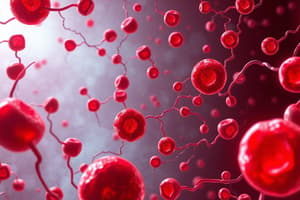Podcast
Questions and Answers
Which anatomical sites are involved in erythropoiesis?
Which anatomical sites are involved in erythropoiesis?
- Tissue hypoxia
- Erythroblasts
- Erythropoietic islands (correct)
- Macrophages
What is the primary stimulus for the production of red blood cells?
What is the primary stimulus for the production of red blood cells?
- Tissue hypoxia (correct)
- Macrophages
- Erythropoietic islands
- Erythroblasts
Which series includes pronormoblast, basophilic normoblast, polychromatophilic normoblast, and orthochromic normoblast?
Which series includes pronormoblast, basophilic normoblast, polychromatophilic normoblast, and orthochromic normoblast?
- RBC maturation series
- Erythroblastic series
- Normoblastic series (correct)
- Rubriblastic series
Which stage of RBC maturation has a nuclear chromatin that becomes more clumped and is the last stage with nucleolus?
Which stage of RBC maturation has a nuclear chromatin that becomes more clumped and is the last stage with nucleolus?
Which RBC precursor takes 3 days to develop into orthochromic normoblast?
Which RBC precursor takes 3 days to develop into orthochromic normoblast?
Flashcards are hidden until you start studying
Study Notes
Erythropoiesis
- Erythropoiesis involves the following anatomical sites: bone marrow, spleen, and liver
- The primary stimulus for the production of red blood cells is hypoxia
Stages of RBC Maturation
- The series of RBC maturation includes: pronormoblast, basophilic normoblast, polychromatophilic normoblast, and orthochromic normoblast
- The polychromatophilic normoblast stage is characterized by nuclear chromatin that becomes more clumped and is the last stage with nucleolus
- The basophilic normoblast takes 3 days to develop into orthochromic normoblast
Studying That Suits You
Use AI to generate personalized quizzes and flashcards to suit your learning preferences.



